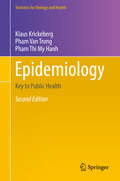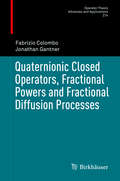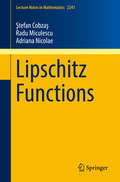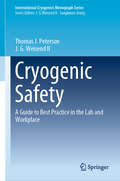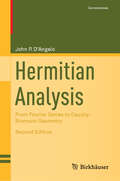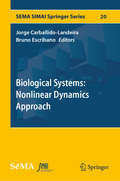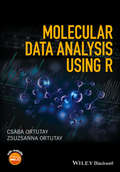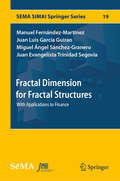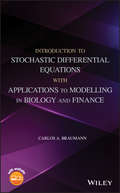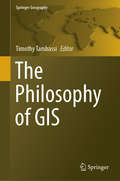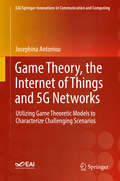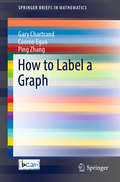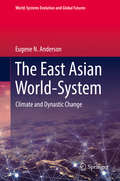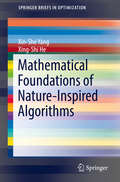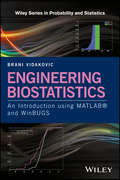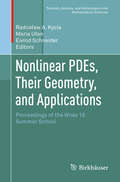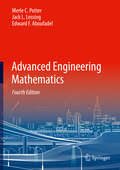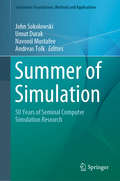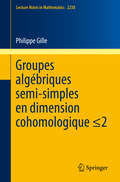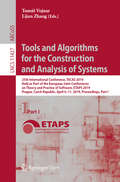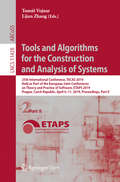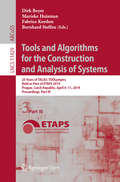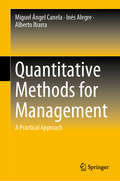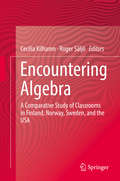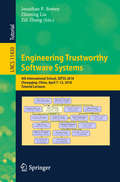- Table View
- List View
Epidemiology: Key to Public Health (Statistics for Biology and Health)
by Klaus Krickeberg Pham Van Trong Pham Thi My HanhThis unique textbook presents the field of modern epidemiology as a whole; it does not restrict itself to particular aspects. It stresses the fundamental ideas and their role in any situation of epidemiologic practice. Its structure is largely determined by didactic viewpoints.Epidemiology is the art of defining and investigating the influence of factors on the health of populations. Hence the book starts by sketching the role of epidemiology in public health. It then treats the epidemiology of many particular diseases; mathematical modelling of epidemics and immunity; health information systems; statistical methods and sample surveys; clinical epidemiology including clinical trials; nutritional, environmental, social, and genetic epidemiology; and the habitual tools of epidemiologic studies. The book also reexamines the basic difference between the epidemiology of infectious diseases and that of non-infectious ones.The organization of the topics by didactic aspects makes the book ideal for teaching. All examples and case studies are situated in a single country, namely Vietnam; this provides a particularly vivid picture of the role of epidemiology in shaping the health of a population. It can easily be adapted to other developing or transitioning countries.This volume is well suited for courses on epidemiology and public health at the upper undergraduate and graduate levels, while its specific examples make it appropriate for those who teach these fields in developing or emerging countries. New to this edition, in addition to minor revisions of almost all chapters:• Updated data about infectious and non-infectious diseases• An expanded discussion of genetic epidemiology• A new chapter, based on recent research of the authors, on how to build a coherent system of Public Health by using the insights provided by this volume.
Quaternionic Closed Operators, Fractional Powers and Fractional Diffusion Processes (Operator Theory: Advances and Applications #274)
by Fabrizio Colombo Jonathan GantnerThis book presents a new theory for evolution operators and a new method for defining fractional powers of vector operators. This new approach allows to define new classes of fractional diffusion and evolution problems. These innovative methods and techniques, based on the concept of S-spectrum, can inspire researchers from various areas of operator theory and PDEs to explore new research directions in their fields.This monograph is the natural continuation of the book: Spectral Theory on the S-Spectrum for Quaternionic Operators by Fabrizio Colombo, Jonathan Gantner, and David P. Kimsey (Operator Theory: Advances and Applications, Vol. 270).
Lipschitz Functions (Lecture Notes in Mathematics #2241)
by Ştefan Cobzaş Radu Miculescu Adriana NicolaeThe aim of this book is to present various facets of the theory and applications of Lipschitz functions, starting with classical and culminating with some recent results. Among the included topics we mention: characterizations of Lipschitz functions and relations with other classes of functions, extension results for Lipschitz functions and Lipschitz partitions of unity, Lipschitz free Banach spaces and their applications, compactness properties of Lipschitz operators, Bishop-Phelps type results for Lipschitz functionals, applications to best approximation in metric and in metric linear spaces, Kantorovich-Rubinstein norm and applications to duality in the optimal transport problem, Lipschitz mappings on geodesic spaces.The prerequisites are basic results in real analysis, functional analysis, measure theory (including vector measures) and topology, which, for reader's convenience, are surveyed in the first chapter of the book.
Cryogenic Safety: A Guide to Best Practice in the Lab and Workplace (International Cryogenics Monograph Series)
by Thomas J. Peterson J. G. Weisend IIThis book describes the current state of the art in cryogenic safety best practice, helping the reader to work with cryogenic systems and materials safely. It brings together information from previous texts, industrial and laboratory safety polices, and recent research papers. Case studies, example problems, and an extensive list of references are included to add to the utility of the text. It describes the unique safety hazards posed by cryogenics in all its guises, including issues associated with the extreme cold of cryogenics, the flammability of some cryogenic fluids, the displacement of oxygen by inert gases boiling off from cryogenic fluids, and the high pressures that can be formed during the volume expansion that occurs when a cryogenic fluid becomes a room temperature gas. A further chapter considers the challenges arising from the behavior of materials at cryogenic temperatures. Many materials are inappropriate for use in cryogenics and can fail, resulting in hazardous conditions. Despite these hazards, work at cryogenic temperatures can be performed safely. The book also discusses broader safety issues such as hazard analysis, establishment of a safe work culture and lessons learned from cryogenic safety in accelerator labs. This book is designed to be useful to everyone affected by cryogenic hazards regardless of their expertise in cryogenics.
Hermitian Analysis: From Fourier Series to Cauchy-Riemann Geometry (Cornerstones)
by John P. D'AngeloThis textbook provides a coherent, integrated look at various topics from undergraduate analysis. It begins with Fourier series, continues with Hilbert spaces, discusses the Fourier transform on the real line, and then turns to the heart of the book, geometric considerations. This chapter includes complex differential forms, geometric inequalities from one and several complex variables, and includes some of the author's original results. The concept of orthogonality weaves the material into a coherent whole. This textbook will be a useful resource for upper-undergraduate students who intend to continue with mathematics, graduate students interested in analysis, and researchers interested in some basic aspects of Cauchy-Riemann (CR) geometry. The inclusion of several hundred exercises makes this book suitable for a capstone undergraduate Honors class.This second edition contains a significant amount of new material, including a new chapter dedicated to the CR geometry of the unit sphere. This chapter builds upon the first edition by presenting recent results about groups associated with CR sphere maps. From reviews of the first edition:The present book developed from the teaching experiences of the author in several honors courses. …. All the topics are motivated very nicely, and there are many exercises, which make the book ideal for a first-year graduate course on the subject. …. The style is concise, always very neat, and proofs are given with full details. Hence, I certainly suggest this nice textbook to anyone interested in the subject, even for self-study. Fabio Nicola, Politecnico di Torino, Mathematical ReviewsD’Angelo has written an eminently readable book, including excellent explanations of pretty nasty stuff for even the more gifted upper division players .... It certainly succeeds in hooking the present browser: I like this book a great deal. Michael Berg, Loyola Marymount University, Mathematical Association of America
Biological Systems: Nonlinear Dynamics Approach (SEMA SIMAI Springer Series #20)
by Jorge Carballido-Landeira Bruno EscribanoThis book collects recent advances in the field of nonlinear dynamics in biological systems. Focusing on medical applications as well as more fundamental questions in biochemistry, it presents recent findings in areas such as control in chemically driven reaction-diffusion systems, electrical wave propagation through heart tissue, neural network growth, chiral symmetry breaking in polymers and mechanochemical pattern formation in the cytoplasm, particularly in the context of cardiac cells. It is a compilation of works, including contributions from international scientists who attended the “2nd BCAM Workshop on Nonlinear Dynamics in Biological Systems,” held at the Basque Center for Applied Mathematics, Bilbao in September 2016. Embracing diverse disciplines and using multidisciplinary approaches – including theoretical concepts, simulations and experiments – these contributions highlight the nonlinear nature of biological systems in order to be able to reproduce their complex behavior. Edited by the conference organizers and featuring results that represent recent findings and not necessarily those presented at the conference, the book appeals to applied mathematicians, biophysicists and computational biologists.
Molecular Data Analysis Using R
by Csaba Ortutay Zsuzsanna OrtutayThis book addresses the difficulties experienced by wet lab researchers with the statistical analysis of molecular biology related data. The authors explain how to use R and Bioconductor for the analysis of experimental data in the field of molecular biology. The content is based upon two university courses for bioinformatics and experimental biology students (Biological Data Analysis with R and High-throughput Data Analysis with R). The material is divided into chapters based upon the experimental methods used in the laboratories. Key features include:• Broad appeal--the authors target their material to researchers in several levels, ensuring that the basics are always covered.• First book to explain how to use R and Bioconductor for the analysis of several types of experimental data in the field of molecular biology.• Focuses on R and Bioconductor, which are widely used for data analysis. One great benefit of R and Bioconductor is that there is a vast user community and very active discussion in place, in addition to the practice of sharing codes. Further, R is the platform for implementing new analysis approaches, therefore novel methods are available early for R users.
Fractal Dimension for Fractal Structures: With Applications to Finance (SEMA SIMAI Springer Series #19)
by Manuel Fernández-Martínez Juan Luis García Guirao Miguel Ángel Sánchez-Granero Juan Evangelista Trinidad SegoviaThis book provides a generalised approach to fractal dimension theory from the standpoint of asymmetric topology by employing the concept of a fractal structure. The fractal dimension is the main invariant of a fractal set, and provides useful information regarding the irregularities it presents when examined at a suitable level of detail. New theoretical models for calculating the fractal dimension of any subset with respect to a fractal structure are posed to generalise both the Hausdorff and box-counting dimensions. Some specific results for self-similar sets are also proved. Unlike classical fractal dimensions, these new models can be used with empirical applications of fractal dimension including non-Euclidean contexts. In addition, the book applies these fractal dimensions to explore long-memory in financial markets. In particular, novel results linking both fractal dimension and the Hurst exponent are provided. As such, the book provides a number of algorithms for properly calculating the self-similarity exponent of a wide range of processes, including (fractional) Brownian motion and Lévy stable processes. The algorithms also make it possible to analyse long-memory in real stocks and international indexes.This book is addressed to those researchers interested in fractal geometry, self-similarity patterns, and computational applications involving fractal dimension and Hurst exponent.
Introduction to Stochastic Differential Equations with Applications to Modelling in Biology and Finance
by Carlos A. BraumannA comprehensive introduction to the core issues of stochastic differential equations and their effective application Introduction to Stochastic Differential Equations with Applications to Modelling in Biology and Finance offers a comprehensive examination to the most important issues of stochastic differential equations and their applications. The author — a noted expert in the field — includes myriad illustrative examples in modelling dynamical phenomena subject to randomness, mainly in biology, bioeconomics and finance, that clearly demonstrate the usefulness of stochastic differential equations in these and many other areas of science and technology. The text also features real-life situations with experimental data, thus covering topics such as Monte Carlo simulation and statistical issues of estimation, model choice and prediction. The book includes the basic theory of option pricing and its effective application using real-life. The important issue of which stochastic calculus, Itô or Stratonovich, should be used in applications is dealt with and the associated controversy resolved. Written to be accessible for both mathematically advanced readers and those with a basic understanding, the text offers a wealth of exercises and examples of application. This important volume: Contains a complete introduction to the basic issues of stochastic differential equations and their effective application Includes many examples in modelling, mainly from the biology and finance fields Shows how to: Translate the physical dynamical phenomenon to mathematical models and back, apply with real data, use the models to study different scenarios and understand the effect of human interventions Conveys the intuition behind the theoretical concepts Presents exercises that are designed to enhance understanding Offers a supporting website that features solutions to exercises and R code for algorithm implementation Written for use by graduate students, from the areas of application or from mathematics and statistics, as well as academics and professionals wishing to study or to apply these models, Introduction to Stochastic Differential Equations with Applications to Modelling in Biology and Finance is the authoritative guide to understanding the issues of stochastic differential equations and their application.
The Philosophy of GIS (Springer Geography)
by Timothy TambassiThis anthology aims to present the fundamental philosophical issues and tools required by the reflection within and upon geography and Geographic Information Systems (GIS) . It is an introduction to the philosophy for GIScience from an analytical perspective, which looks at GIS with a specific focus on its fundamental and most general concepts and distinctions. The first part of the book is devoted to explore some of the main philosophical questions arising from GIS and GIScience, which include, among others, investigations in ontology, epistemology, linguistics and geometrical modeling. The second part concerns issues related to spatial and cartographical representations of the geographical world. The third part is focused on the ontology of geography, specifically in terms of geographical entities, objects and boundaries. Finally, in the fourth part, the topic of GIS constitutes a starting point for exploring themes such as quantum geography and disorientation, and for defining professional profiles for geographers with competences in GIS environment. This book on a new and unexplored field of research could be a fundamental point of reference for professional philosophers and geographers interested in the theoretical reflection about the foundational concepts of GIScience. It is also interesting reading material for students (both undergraduates, postgraduates and Ph.D. students) in philosophy, geography, applied ontology, GIScience, geomatics and computer science.
Game Theory, the Internet of Things and 5G Networks: Utilizing Game Theoretic Models to Characterize Challenging Scenarios (EAI/Springer Innovations in Communication and Computing)
by Josephina AntoniouThis book shows how to model selected communication scenarios using game theory. The book helps researchers specifically dealing with scenarios motivated by the increasing use of the Internet of Things (IoT) and 5G Communications by using game theory to approach the study of such challenging scenarios. The author explains how game theory acts as a mathematical tool that models decision making in terms of strategies and mechanisms that can result in optimal payoffs for a number of interacting entities, offering often antagonistic behaviors. The book explores new technologies in terms of design, development and management from a theoretical perspective, using game theory to analyze strategic situations and demonstrate profitable behaviors of the cooperative entities. The book identifies and explores several significant applications/uses/situations that arise from the vast deployment of the IoT. The presentation of the technological scenarios is followed in each of the first four chapters by a step-by-step theoretical model often followed by equilibrium proof, and numerical simulation results, that are explained in a tutorial-like manner. The four chapters tackle challenging IoT and 5G related issues, including: new security threats that IoT brings, e.g. botnets, ad hoc vehicular networks and the need for trust in vehicular communications, content repetition by offloading traffic onto mobile users, as well as issues due to new wearable devices that enable data collection to become more intrusive.
How to Label a Graph (SpringerBriefs in Mathematics)
by Gary Chartrand Cooroo Egan Ping ZhangThis book depicts graph labelings that have led to thought-provoking problems and conjectures. Problems and conjectures in graceful labelings, harmonious labelings, prime labelings, additive labelings, and zonal labelings are introduced with fundamentals, examples, and illustrations. A new labeling with a connection to the four color theorem is described to aid mathematicians to initiate new methods and techniques to study classical coloring problems from a new perspective. Researchers and graduate students interested in graph labelings will find the concepts and problems featured in this book valuable for finding new areas of research.
The East Asian World-System: Climate and Dynastic Change (World-Systems Evolution and Global Futures)
by Eugene N. AndersonThis book studies the East Asian world-system and its dynastic cycles as they were influenced by climate and demographic change, diseases, the expansion of trade, and the rise of science and technology. By studying the history of East Asia until the beginning of the 20th century and offering a comparative perspective on East Asian countries, including China, Japan and Korea, it describes the historical evolution of the East Asian world-system as being the result of good or poor management of the respective populations and environments. Lastly, the book discusses how the East Asian regions have become integrated into a single world-system by a combination of trade, commerce, and military action. Given its scope, the book will appeal to scholars of history, sociology, political science and environmental studies, and to anyone interested in learning about the effects of climate change on the dynamic development of societies.
Mathematical Foundations of Nature-Inspired Algorithms (SpringerBriefs in Optimization)
by Xin-She Yang Xing-Shi HeThis book presents a systematic approach to analyze nature-inspired algorithms. Beginning with an introduction to optimization methods and algorithms, this book moves on to provide a unified framework of mathematical analysis for convergence and stability. Specific nature-inspired algorithms include: swarm intelligence, ant colony optimization, particle swarm optimization, bee-inspired algorithms, bat algorithm, firefly algorithm, and cuckoo search. Algorithms are analyzed from a wide spectrum of theories and frameworks to offer insight to the main characteristics of algorithms and understand how and why they work for solving optimization problems. In-depth mathematical analyses are carried out for different perspectives, including complexity theory, fixed point theory, dynamical systems, self-organization, Bayesian framework, Markov chain framework, filter theory, statistical learning, and statistical measures. Students and researchers in optimization, operations research, artificial intelligence, data mining, machine learning, computer science, and management sciences will see the pros and cons of a variety of algorithms through detailed examples and a comparison of algorithms.
Engineering Biostatistics: An Introduction using MATLAB and WinBUGS (Wiley Series in Probability and Statistics)
by Brani VidakovicProvides a one-stop resource for engineers learning biostatistics using MATLAB® and WinBUGS Through its scope and depth of coverage, this book addresses the needs of the vibrant and rapidly growing bio-oriented engineering fields while implementing software packages that are familiar to engineers. The book is heavily oriented to computation and hands-on approaches so readers understand each step of the programming. Another dimension of this book is in parallel coverage of both Bayesian and frequentist approaches to statistical inference. It avoids taking sides on the classical vs. Bayesian paradigms, and many examples in this book are solved using both methods. The results are then compared and commented upon. Readers have the choice of MATLAB® for classical data analysis and WinBUGS/OpenBUGS for Bayesian data analysis. Every chapter starts with a box highlighting what is covered in that chapter and ends with exercises, a list of software scripts, datasets, and references. Engineering Biostatistics: An Introduction using MATLAB® and WinBUGS also includes: parallel coverage of classical and Bayesian approaches, where appropriate substantial coverage of Bayesian approaches to statistical inference material that has been classroom-tested in an introductory statistics course in bioengineering over several years exercises at the end of each chapter and an accompanying website with full solutions and hints to some exercises, as well as additional materials and examples Engineering Biostatistics: An Introduction using MATLAB® and WinBUGS can serve as a textbook for introductory-to-intermediate applied statistics courses, as well as a useful reference for engineers interested in biostatistical approaches.
Nonlinear PDEs, Their Geometry, and Applications: Proceedings of the Wisła 18 Summer School (Tutorials, Schools, and Workshops in the Mathematical Sciences)
by Radosław A. Kycia Maria Ułan Eivind SchneiderThis volume presents lectures given at the Summer School Wisła 18: Nonlinear PDEs, Their Geometry, and Applications, which took place from August 20 - 30th, 2018 in Wisła, Poland, and was organized by the Baltic Institute of Mathematics. The lectures in the first part of this volume were delivered by experts in nonlinear differential equations and their applications to physics. Original research articles from members of the school comprise the second part of this volume. Much of the latter half of the volume complements the methods expounded in the first half by illustrating additional applications of geometric theory of differential equations. Various subjects are covered, providing readers a glimpse of current research. Other topics covered include thermodynamics, meteorology, and the Monge–Ampère equations.Researchers interested in the applications of nonlinear differential equations to physics will find this volume particularly useful. A knowledge of differential geometry is recommended for the first portion of the book, as well as a familiarity with basic concepts in physics.
Advanced Engineering Mathematics
by Merle C. Potter Jack L. Lessing Edward F. AboufadelThis book is designed to serve as a core text for courses in advanced engineering mathematics required by many engineering departments. The style of presentation is such that the student, with a minimum of assistance, can follow the step-by-step derivations. Liberal use of examples and homework problems aid the student in the study of the topics presented. Ordinary differential equations, including a number of physical applications, are reviewed in Chapter One. The use of series methods are presented in Chapter Two, Subsequent chapters present Laplace transforms, matrix theory and applications, vector analysis, Fourier series and transforms, partial differential equations, numerical methods using finite differences, complex variables, and wavelets. The material is presented so that four or five subjects can be covered in a single course, depending on the topics chosen and the completeness of coverage.Incorporated in this textbook is the use of certain computer software packages. Short tutorials on Maple, demonstrating how problems in engineering mathematics can be solved with a computer algebra system, are included in most sections of the text. Problems have been identified at the end of sections to be solved specifically with Maple, and there are computer laboratory activities, which are more difficult problems designed for Maple. In addition, MATLAB and Excel have been included in the solution of problems in several of the chapters.There is a solutions manual available for those who select the text for their course. This text can be used in two semesters of engineering mathematics. The many helpful features make the text relatively easy to use in the classroom.
Summer of Simulation: 50 Years of Seminal Computer Simulation Research (Simulation Foundations, Methods and Applications)
by Andreas Tolk Umut Durak Navonil Mustafee John SokolowskiThis book is based on the “Summer Simulation Multi-Conference” (SCSC), which has been a prominent platform for the dissemination of scholarly research in the M&S community for the last 50 years. In keeping with the conference’s seasonal title, the authors have called this half-century “the summer of simulation,” and it has led not only to simulation-based disciplines but also simulation as a discipline. This book discusses contributions from the SCSC in four sections. The first section is an introduction to the work. The second section is devoted to contributions from simulation research fellows who were associated with the SCSC, while the third section features the SCSC’s most influential contributions. Lastly, the fourth section includes contributions from the best papers in the last five years.Features:• A comprehensive volume dedicated to one of the simulation domain’s major conferences: the SCSC• Offers a scientometric analysis of the SCSC• Revisits high-impact topics from 50 years of the SCSC• Includes chapters by simulation research fellows associated with the SCSC• Presents updated best-paper contributions from the recent conferenceThis work will be of value to anyone interested in the evolution of modeling and simulation over the last fifty years. Readers will gain a perspective on what drove this evolution, and develop an understanding of the key contributions that allowed this technology to grow into its own academic discipline and profession.
Groupes algébriques semi-simples en dimension cohomologique ≤2: Semisimple algebraic groups in cohomological dimension ≤2 (Lecture Notes in Mathematics #2238)
by Philippe GilleLa théorie des groupes algébriques sur un corps arbitraire est l’une des branches les plus merveilleuses des mathématiques modernes. Cette monographie porte sur les groupes algébriques semi-simples définis sur un corps k de dimension cohomologique séparable ≤2 et la cohomologie galoisienne d’iceux. La question ouverte la plus importante est la conjecture II de Serre (1962) qui prédit l’annulation de la cohomologie galoisienne d’un groupe semi-simple simplement connexe.Utilisant principalement des techniques de groupes algébriques, on couvre tous les cas connus de la conjecture: les cas classiques (dus à Bayer-Fluckiger and Parimala) ainsi que les avancées sur les cas exceptionnels restants (par exemple de type E8). Ceci s’applique à la classification des groupes semi-simples. The theory of algebraic groups over arbitrary fields is one of the most beautiful branches of modern mathematics. This monograph deals with semisimple algebraic groups over a general field k of separable cohomological dimension ^ to Bayer-Fluckiger and Parimala), and some perspectives are given on the remaining exceptional cases (e.g., G of type E8). Applications to the classification of semisimple k-groups are presented.
Tools and Algorithms for the Construction and Analysis of Systems: 25th International Conference, TACAS 2019, Held as Part of the European Joint Conferences on Theory and Practice of Software, ETAPS 2019, Prague, Czech Republic, April 6–11, 2019, Proceedings, Part I (Lecture Notes in Computer Science #11427)
by Tomáš Vojnar Lijun ZhangThis book is Open Access under a CC BY licence. The LNCS 11427 and 11428 proceedings set constitutes the proceedings of the 25th International Conference on Tools and Algorithms for the Construction and Analysis of Systems, TACAS 2019, which took place in Prague, Czech Republic, in April 2019, held as part of the European Joint Conferences on Theory and Practice of Software, ETAPS 2019. The total of 42 full and 8 short tool demo papers presented in these volumes was carefully reviewed and selected from 164 submissions. The papers are organized in topical sections as follows: Part I: SAT and SMT, SAT solving and theorem proving; verification and analysis; model checking; tool demo; and machine learning. Part II: concurrent and distributed systems; monitoring and runtime verification; hybrid and stochastic systems; synthesis; symbolic verification; and safety and fault-tolerant systems.
Tools and Algorithms for the Construction and Analysis of Systems: 25th International Conference, TACAS 2019, Held as Part of the European Joint Conferences on Theory and Practice of Software, ETAPS 2019, Prague, Czech Republic, April 6–11, 2019, Proceedings, Part II (Lecture Notes in Computer Science #11428)
by Tomáš Vojnar Lijun ZhangThis book is Open Access under a CC BY licence. The LNCS 11427 and 11428 proceedings set constitutes the proceedings of the 25th International Conference on Tools and Algorithms for the Construction and Analysis of Systems, TACAS 2019, which took place in Prague, Czech Republic, in April 2019, held as part of the European Joint Conferences on Theory and Practice of Software, ETAPS 2019. The total of 42 full and 8 short tool demo papers presented in these volumes was carefully reviewed and selected from 164 submissions. The papers are organized in topical sections as follows: Part I: SAT and SMT, SAT solving and theorem proving; verification and analysis; model checking; tool demo; and machine learning. Part II: concurrent and distributed systems; monitoring and runtime verification; hybrid and stochastic systems; synthesis; symbolic verification; and safety and fault-tolerant systems.
Tools and Algorithms for the Construction and Analysis of Systems: 25 Years of TACAS: TOOLympics, Held as Part of ETAPS 2019, Prague, Czech Republic, April 6–11, 2019, Proceedings, Part III (Lecture Notes in Computer Science #11429)
by Dirk Beyer Marieke Huisman Fabrice Kordon Bernhard SteffenThis book is Open Access under a CC BY licence. This book, LNCS 11429, is part III of the proceedings of the 25th International Conference on Tools and Algorithms for the Construction and Analysis of Systems, TACAS 2019, which took place in Prague, Czech Republic, in April 2019, held as part of the European Joint Conferences on Theory and Practice of Software, ETAPS 2019. It's a special volume on the occasion of the 25 year anniversary of TACAS.
Quantitative Methods for Management: A Practical Approach
by Miguel Ángel Canela Inés Alegre Alberto IbarraThis book focuses on the use of quantitative methods for both business and management, helping readers understand the most relevant quantitative methods for managerial decision-making. Pursuing a highly practical approach, the book reduces the theoretical information to a minimum, so as to give full prominence to the analysis of real business problems.Each chapter includes a brief theoretical explanation, followed by a real-life managerial case that needs to be solved, which is accompanied by a corresponding Microsoft Excel® dataset. The practical cases and exercises are solved using Excel, and for each problem, the authors provide an Excel file with the complete solution and corresponding calculations, which can be downloaded easily from the book’s website. Further, in an appendix, readers can find solutions to the same problems, but using the R statistical language.The book represents a valuable reference guide for postgraduate, MBA and executive education students, as it offers a hands-on, practical approach to learning quantitative methods in a managerial context. It will also be of interest to managers looking for a practical and straightforward way to learn about quantitative methods and improve their decision-making processes.
Encountering Algebra: A Comparative Study of Classrooms in Finland, Norway, Sweden, and the USA
by Cecilia Kilhamn Roger SäljöThe book reports a comparative research project about algebra teaching and learning in four countries. Algebra is a central topic of learning across the world, and it is well-known that it represents a hurdle for many students. The book presents analyses built on extensive video-recordings of classrooms documenting the first introduction to symbolic algebra (students aged 12 to 14). While the content addressed in all classrooms is variables, expressions and equations, the teaching approaches are diverse. The chapters bring the reader into different algebra classrooms, discussing issues such as mathematization and social norms, the role of mediating tools and designed examples, and teacher beliefs. By comparing classrooms, new insights are generated about how students understand the algebraic content, how teachers instruct, and how both parties deal with difficulties in learning elementary algebra. The book also describes a research methodology using video in search of taken-for-granted aspects of algebra lessons.
Engineering Trustworthy Software Systems: 4th International School, SETSS 2018, Chongqing, China, April 7–12, 2018, Tutorial Lectures (Lecture Notes in Computer Science #11430)
by Jonathan P. Bowen Zhiming Liu Zili ZhangThis volume contains lectures on leading-edge research in methods and tools for use in computer system engineering; at the 4th International School on Engineering Trustworthy Software Systems, SETSS 2018, held in April 2018 at Southwest University in Chongqing, China.The five chapters in this volume provide an overview of research in the frontier of theories, methods, and tools for software modelling, design, and verification. The topics covered in these chapter include Software Verification with Whiley, Learning Büchi Automata and Its Applications, Security in IoT Applications, Programming in Z3, and The Impact of Alan Turing: Formal Methods and Beyond. The volume provides a useful resource for postgraduate students, researchers, academics, and engineers in industry, who are interested in theory, methods, and tools for the development of trustworthy software.
